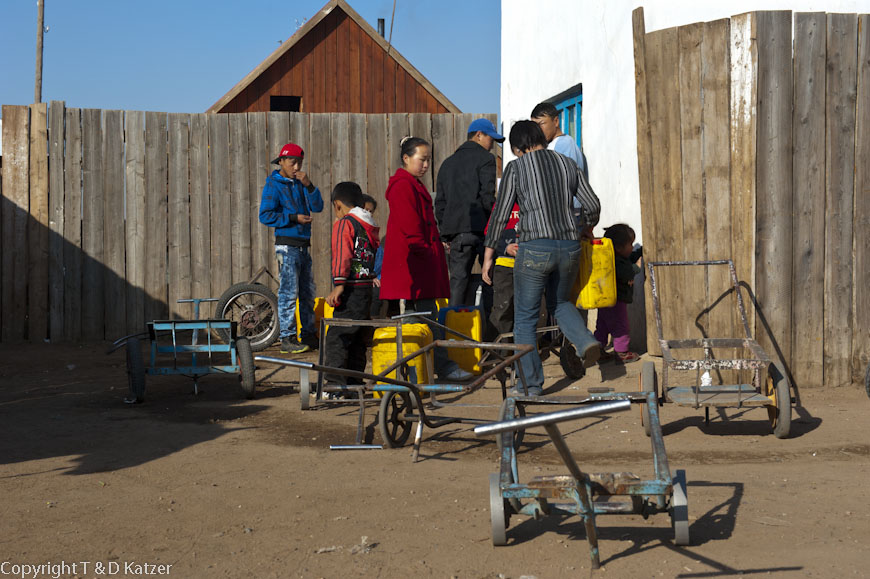
Fourth summary – Complex preparations for wintering
N 49°01'801'' E 104°03'566''
Day: 435
Sunrise:
07:03
Sunset:
18:43
Total kilometers:
2522
Soil condition:
Asphalt
Temperature – Day (maximum):
0 °C
Temperature – day (minimum):
minus 4 °C
Temperature – Night:
minus 3 °C
Latitude:
49°01’801”
Longitude:
104°03’566”
Maximum height:
1422 m above sea level



In the village, which was plagued by dust, we moved into a yurt that Saraa and her husband Gonchig set up for us. We were soon visiting the market every day and buying all the household items needed to survive an extreme winter in a yurt. Since there was only Chinese junk on sale, it was a challenge. Above all, getting a usable chainsaw that didn’t break down after the first tree trunk I cut up was a difficult task. The complexity and difficult preparation required exceptional stamina and nerves of steel. “You have to take care of firewood. When it starts to snow in the taiga, it’s impossible to get the wood,” Saraa warned us and suggested we talk to her cousin who lived in Tsagaan Nuur. The eighty-five-year-old promised to organize two truckloads of firewood for us, but only if we transferred money first. We transferred 80,000 Tugrik and were relieved to have solved another problem.
To make it more difficult for horse thieves, we branded our horses. Another important point of preparation was to request an audience with the second mayor of Mörön. After a long, fruitful conversation, he said: “I will support you with all my strength. Tomorrow my secretary will write them an official letter. That way, everyone will know that the Khuvgul government is working with them. This will also give you a certain degree of security. If you have any problems, please contact me.” This gave our risky venture a stable foundation that could prove invaluable to us in the coming months. Before we knew it, the influential politician’s secretary had arranged for us to appear on local television. We spent 30 minutes talking about our big trip and the upcoming winter.
When we found out about the wolves that were going to kill our horses in the taiga, we reached a critical point. Bilgee immediately agreed to ride the horses back to Erdenet. We were relieved, at least until we learned that he was demanding a sum of 5.7 million tugrik for the wintering of the animals. An amount that could have bought 14 to 16 horses. Together with Saraa, we looked for solutions. The decisive idea came from Gonchig, who worked as a lieutenant warden in Mörön prison. He told us about the possibility of integrating our animals into the military’s herd of horses and thus giving them a good chance of survival. As the prisons in this country are under the control of the military, he put us in touch with the director of the prison. “They’ll get our horses through the winter safely and in return we’ll pay for new windows for the dilapidated prison building,” I offered, to which Major Batjargal agreed enthusiastically. Happy with a social action to protect our mounts from the wolves, we signed a contract and cleared another hurdle.
Bilgee, however, changed his mind and out of the blue no longer wanted to bring the horses from Tsagaan Nuur back to Mörön. He was probably disappointed not to have got the job. Frustrated, he got drunk and became delirious for 24 hours. Although we had ensured the survival of the horses, the big question now was how to get them back to Mörön from the north. We were getting desperate until Saraa and Gonchig had the idea of asking a relative of theirs if he wanted to take on the task for a fee. Tulgaa agreed, which took a load off our minds.
After almost three weeks we had completed our yurt furnishings. The question now was how we were going to get the 700 kilograms of heavy equipment and food over the 400 kilometers of clay and gravel road to Tsagaan Nuur? We negotiated unsuccessfully with various drivers until Saraa stepped in again and promised to have all the material transported to one of the most remote places on earth at a fair price.
We look forward to your comments!

